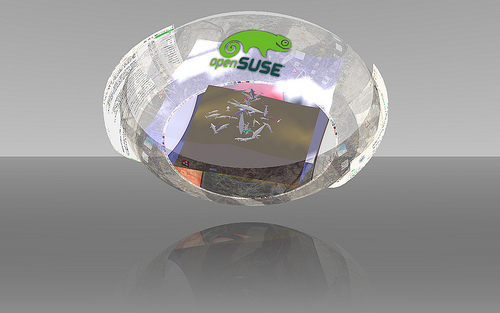Dude, where’s the party?
by cyberorg,
Tuesday, June 17th @ 6:24 pm Comments (2)
openSUSE 11.0 is coming, join the party if you are in my town - Vadodara/Baroda, put yourself on this list. We’d be distributing DVDs, doing a small presentation introducing all the cool new stuff and of course have some beverages and snacks ![]()
Here is a party locator, if you cannot find the one closest to you, organize your own!!
Getting NVIDIA and ATI drivers on openSUSE 11.0
by cyberorg,
Friday, June 13th @ 4:41 pm Comments (34)
openSUSE 11.0 just went Gold, and would be available on mirrors in 5 days, here is a handy guide to get ATI and NVIDIA drivers, use whichever way that suite you.
![]()
![]()
Or commandline friendly
su -c “OCICLI http://opensuse-community.org/ati.ymp”
su -c “OCICLI http://opensuse-community.org/nvidia.ymp”
One more commandline way via zypper:
NVIDIA:
zypper sa http://download.nvidia.com/opensuse/11.0 nvidia
zypper in x11-video-nvidiaG01
ATI:
zypper sa http://www2.ati.com/suse/11.0 ati
zypper in x11-video-fglrxG01
No manual configuration of xorg.conf or switching on Xgl required to get compiz goodness, just launch simple-ccsm and enable compiz from there after installing the drivers.
Useful openSUSE One-Click installs from command line
by cyberorg,
Tuesday, June 10th @ 12:51 pm Comments (8)
Another neat feature in openSUSE 11.0 is that we now have a way of installing One-Click patterns via a command line (click-commandline?).
Here are a bunch of softwares you can install via 1-click or OCICLI:
Open terminal to run these commands or click on the link in web browser:
Compiz Fusion with almost everything:
su -c “OCICLI http://download.opensuse.org/repositories/X11:/XGL/openSUSE_11.0/compiz-fusion-all.ymp”
Codecs pack for Gnome:
su -c “OCICLI http://opensuse-community.org/codecs-gnome.ymp”
Codecs pack for KDE:
su -c “OCICLI http://opensuse-community.org/codecs-kde.ymp”
When NVIDIA and ATI drivers are available, they can be installed in a same way too.
Note: Quotes are necessary, make sure there is no “wordpress effect” when you copy paste the above commands in shell.
Sneak Peeks at openSUSE 11.0: Compiz, with Dennis Kasprzyk
by cyberorg,
Sunday, June 8th @ 1:12 pm Comments (0)
To welcome openSUSE 11.0 that will be released later this month, Francis Giannaros and his team at http://news.opensuse.org are doing a “Sneak Peaks” at the special features that distinguish openSUSE 11.0 from other distributions. Check out the feature on Compiz in openSUSE 11.0 and an interview with Dennis “onestone” Kasprzyk, openSUSE user and Compiz Core and Compiz Fusion developer.
openSUSE touch to PulseAudio
by cyberorg,
Monday, June 2nd @ 1:35 pm Comments (4)
Couple of weeks back I posted information about a tiny usability enhancement in simple-ccsm added by Rodrigo that enables users to switch on/off Compiz effects. This time below is a PulseAudio preference(papref) application enhancement that allows setting of speaker layout on the fly.
I am sure most people wont like fiddling with config files to get multiple speaker setup working, hopefully this little enhancement would spread sweet music all around.
Check out other screenshots captured at various stages of openSUSE 11.0 development.
Compiz and Compiz Fusion 0.7.6 out in wild
by cyberorg,
Sunday, June 1st @ 7:57 am Comments (10)
Our friends Dennis Kasprzyk and Guillaume Seguin announced the release of Compiz and Compiz Fusion 0.7.6 respectively. As is the tradition we always make a release with a lot of new features and of course eye-candy to go with it.
In the new features there is now a new “Static Switcher” that shows thumbnails of all the open windows and moves caret instead of thumbnails. Place plugin received a rewrite that enhances it’s multi-display support. Gtk-window-decorator is now accesessibilit(a11y) sensitive and ezoom plugin now has area zoom, helping people with disabilities to work on computer with ease.
Eye-candy? Full sphere!! I’ll let a picture talk for itself.
openSUSE users head to X11:XGL repository and use 1-click install for your distro version. Notice new openSUSE_11.0 repository ![]()
Announcing openSUSE KIWI-LTSP 0.3.16
by cyberorg,
Friday, May 30th @ 8:46 pm Comments (3)
Hello Community
I am happy to announce another release of KIWI-LTSP - LTSP5
implementation on openSUSE using KIWI imaging technology.
The major changes from the last release are:
- kiwi-ltsp-prebuilt image built from openSUSE 11.0 RC1
- We are not using aufs again, replacing split image system
- Fix for Blank screen instead of LDM
- Mount of local device now properly shows up on users’ desktop
Installation instructions remain the same:
1. Use kiwi-ltsp-prebuilt 1-click install from
http://download.opensuse.org/repositories/server:/ltsp/
2. Put your server IP address, dhcp interface to use and dhcp IP range
you want to give to the clients in /etc/sysconfig/kiwi-ltsp either via
your favourite text editor or YaST sysconfig editor GUI.
3. Run kiwi-ltsp-setup -c
You can now pxeboot clients.
Bugs, enhancement requests, patches welcome at
For live help you can always
drop in IRC Freenode #ltsp or #kiwi.
Have a lot of fun!
openSUSE Google Summer of Code project: LTSP-GUI update
by cyberorg,
Wednesday, May 28th @ 6:34 pm Comments (0)
The coding for the Google Summer of Code 08 officially has started from 26th May. Here is the status of our project.
* The transcript of our weekly meeting can be found here.
* The documentation including project specification is here.
* Initial code for the project is already in svn repository.
* The project page including instructions about how to access svn is here.
* Jan weber, the SOC student is keeping his blog updated with the progress of the project.
The project is development of GUI for LTSP in Mono, so if you are familiar with Mono have a look at the code once in a while and give your feedback.
Novell ZenWorks and Buddhist Caves
by cyberorg,
Friday, May 23rd @ 1:55 pm Comments (0)
Just back from a two day ZenWorks Linux Management training at Novell office in Bombay. On the third day, did a little bit of tourist thing, visited Kanheri Caves.
Here are some of the pictures.
Rest of the images here.
Announcing KIWI-LTSP 0.3.15 for openSUSE
by cyberorg,
Sunday, May 18th @ 3:04 pm Comments (1)
Hello Community
Here is another milestone of KIWI-LTSP - a LTSP5 implementation on openSUSE using KIWI imaging technology.
Major changes from the last release are:
- Boot and LTSP images based on openSUSE 11.0 Beta3
- Patches from Jacob Parry for lbmount fixing ownership and permissions. HPJ is working on getting GNOME patched up to fix mounts showing on all users.
- Added ltsp-build-client and ltsp-server-initialize wrapper scripts in preparation for LTSP GUI
- Added python so jetpipe for printing works once again
- Synced all ltsp packages with upstream
Follow these three simple steps to get LTSP5 on openSUSE:
1. 1-click install of kiwi-ltsp-prebuilt image from
http://en.opensuse.org/LTSP (about 100M image, so need good internet
connection)
2. Edit /etc/sysconfig/kiwi-ltsp either via YaST sysconfig editor GUI
or any text editor of your preference, fill in server IP, name server
and dhcp IP range to give to all clients.
3. Run ltsp-server-initialize to configure and enable all the required services
Thanks to Lars Vogdt, founder and maintainer of openSUSE-Edu project, we now have KIWI-LTSP integrated in upcoming openSUSE-Edu release for 10.3 as well as 11.0.
In case you need to customize how the thin client behave, change /srv/tftpboot/KIWI/lts.conf. Explanation of what you can put there is given here: http://doc.ubuntu.com/edubuntu/edubuntu/handbook/C/customizing-thin-client.html
We are working on a GUI to manage the lts.conf and other configuration as a part of Google Summer of Code, Jan Weber is keeping records of
the progress so far here: http://www.luckylemon.de/ and the project white board with more information
Thanks to all who have contributed to the project, especially gbolte and japerry for all the testing and patches.
Have a lot of fun!
-J
